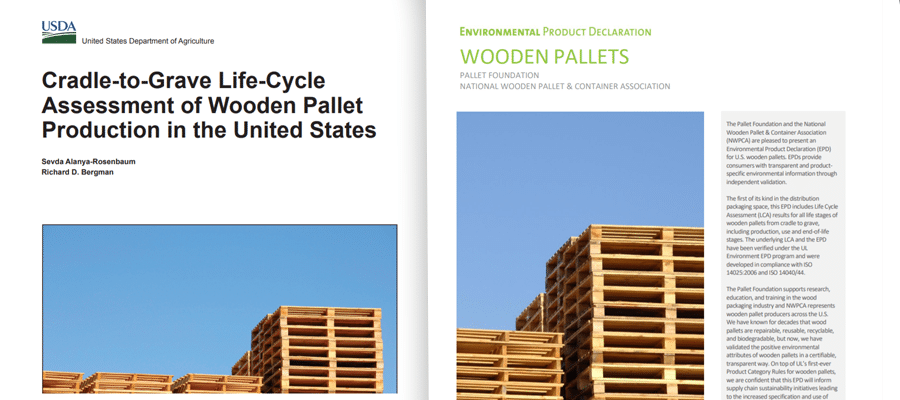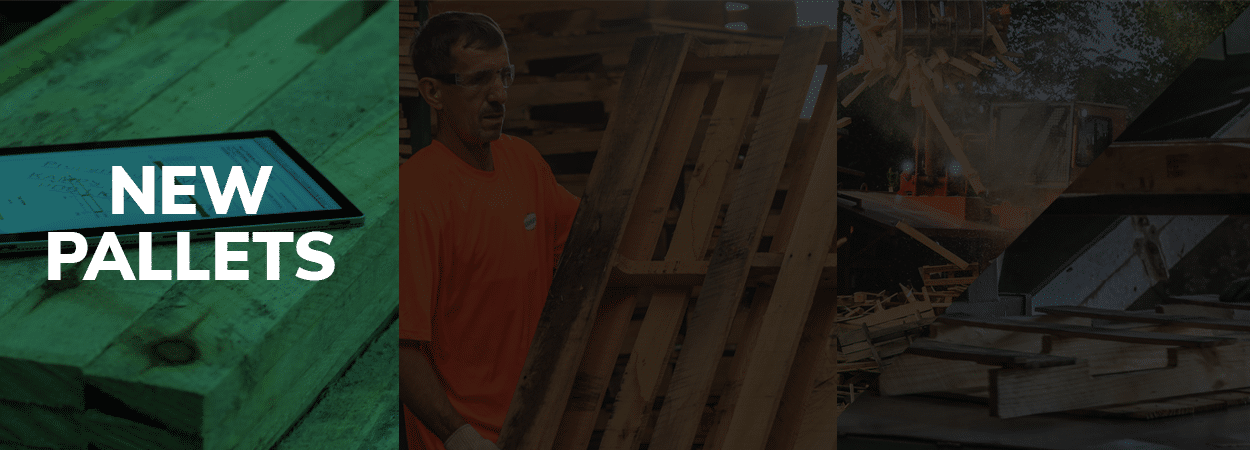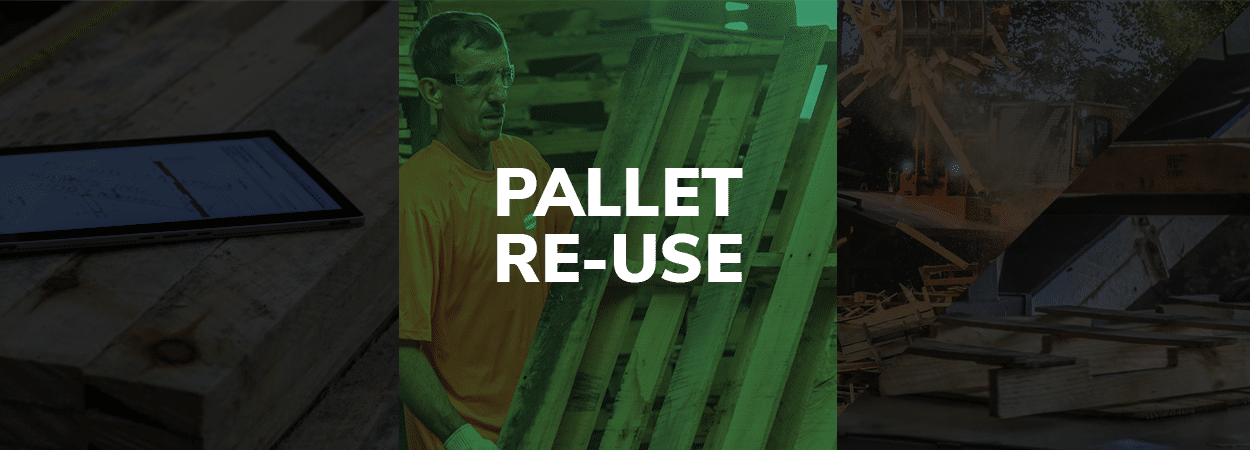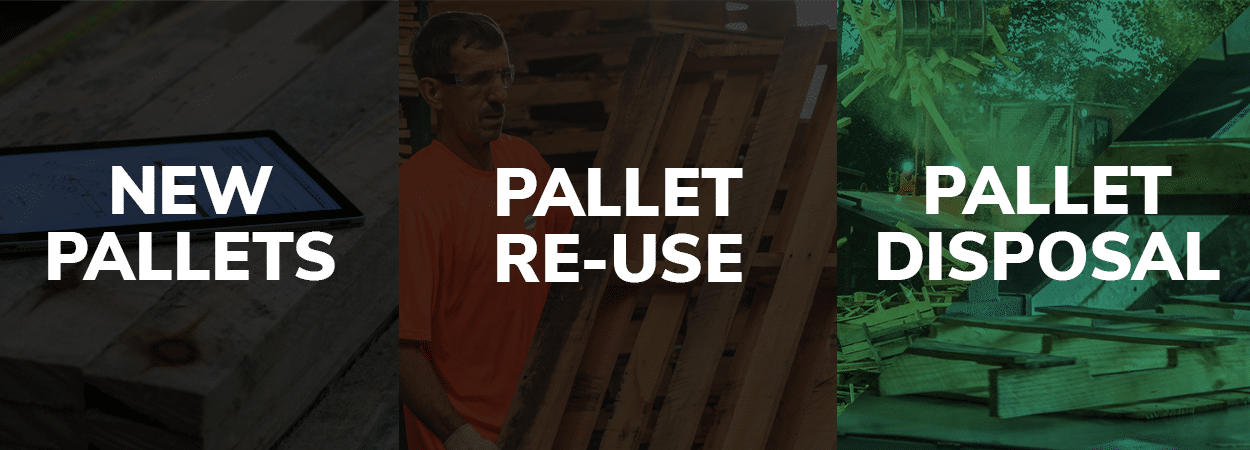Last week, the NWPCA in conjunction with the Pallet Foundation and the U.S. Forest Service’s research wing (U.S. Forest Product Lab) released the Environmental Product Declaration (EPD) for Wood Pallets manufactured in the U.S.
The EPD for Wood Pallets is a breakthrough moment in our industry as it quantifies the environmental impact of the wooden pallet – from cradle to grave.
Before we can start unpacking the results and what they mean for our industry and customers, it is important to appreciate the history of the EPD and give some background information on the documents published first.
What is an EPD?
An Environmental Product Declaration (EPD) is defined by the International Organization for Standardization as a declaration that “quantifies environmental information on the life cycle of a product to enable comparisons between products fulfilling the same function”.
Essentially, EPDs allow businesses to quantify and understand the complete impact of a product on our environment before implementing it into their operations. This allows businesses to make better informed decisions when sourcing products.
How Was The Wooden Pallets EPD Created?
The U.S. Wooden Pallets EPD was spearheaded by the National Wood Pallet & Container Association (NWPCA), an association of which Kamps Pallets is a proud member, and The Pallet Foundation – in conjunction with Forest Products Lab, the research wing of the U.S. Forest Service.
The EPD was created through various industry expert surveys and first-hand research. It is certified by UL, a global leader in third-party EPD certification.

What’s The Big Deal?
Since the birth of the wooden pallet, our industry has touted the reusable, recyclable, and biodegradable qualities of the product. Data and research have been released that support the notion that wood pallets and sustainable forestry have a positive impact on forest cover globally. Our Kamps Green Scorecard shows the positive impact our pallet recycling efforts have on the environment.
However, the industry has never had a certified document to stand behind that covers the entire spectrum of the environmental impact of a wooden pallet from cradle to grave – until now.
This EPD is the first of its kind in the distribution packaging space and includes a Life Cycle Assessment (LCA) for all stages of a wooden pallet’s life cycle.
What Are The Results of the EPD
Results and Figures Courtesy of the NWPCA & Pallet Foundation
The EPD Life-Cycle Assessment shows that with proper disposal and recycling practices wooden pallets can be considered a carbon-neutral product. It also proves that repairing (reconditioning) a pallet or using harvested wood materials from tear-down pallets (remanufacturing) to build pallets is far more environmentally friendly than manufacturing a brand-new pallet.
In short, the wooden pallet is one of the simplest solutions available to making supply chains more sustainable and efficient.
These findings are extremely encouraging for the pallet industry and reinforce the importance pallet recycling plays in environmental sustainability.
Read Our Environmental Sustainability Report
The world around us continues to change, find out how Kamps’ innovative spirit is helping us meet sustainability goals and how we can help your organization reach its own.
Environmental Impact Broken Down By Stage
New Pallet Production
The Life-Cycle Assessment within the EPD revealed that the largest environmental and Global Warming Potential (GWP) impact occurred during the new pallet production stage of a wooden pallet’s life-cycle. This stage includes Raw Materials Supply, Transportation, and Manufacturing. Over 92% of the GWP of the pallet’s entire life-cycle can be attributed to this stage. The manufacturing step of this stage has the highest impact of any step – contributing 35% of a pallet’s total global warming impact. Most of the greenhouse gases (GHGs), that contribute to GWP, released were as a result of the sawing and (kiln) drying processes, which are part of the raw materials supply portion of the new product stage.
Reconditioning & Remanufacturing Pallets
When analyzing the repair and reuse stage of the pallet’s life-cycle, research shows that this stage only contributes 0.78 kg CO2 eq to GWP. This equates to only 7.5% of the total pallet’s life cycle contribution to GWP. This is a significantly lower impact than manufacturing a brand-new pallet – indicating that repairing or remanufacturing a pallet is a more sustainable and environmentally friendly option.
End-of-Life
When analyzing the end-of-life stages (Disposal and Recycling), research shows that proper recycling practices during these two stages can have a negative GW impact of -11.5 kg CO2e per FU.
Proper end-of-life recycling initiatives offset the GHG emissions for the entire pallet life-cycle – resulting in the potential for a carbon-neutral product.
Proper recycling practices featured in the end-of-life stages include: dismantling pallets for re-use (remanufacturing), grinding pallets for mulch, grinding pallets for animal bedding, and grinding pallets for energy use.
What The EPD Means for Wood Pallet Manufacturers
The EPD is a document that justifies the positive environmental impact wooden pallets can have on our planet and positions the product as the go-to green supply chain solution for shipping. We can also use the EPD to critically analyze the pallet industry and use it as a guide to a more sustainable future.
As a guide, the EPD should serve 3 key purposes for pallet manufacturers.
Purpose 1: Encourage Innovation in New Pallet Product Stage
As the Life Cycle Assessment shows, the new product manufacturing stage has the largest negative impact on our environment and GWP. While this is still lower than some other packaging and shipping options, we believe that with innovations in manufacturing that we can lower the impact of this stage even further.
Purpose 2: Encourage Reconditioned & Remanufactured Pallets
The significantly lower impact reconditioned and remanufactured pallets have on our environment compared to new pallets should encourage pallet manufacturers to offer these products to customers whenever possible. By harnessing the green benefits of reconditioned or remanufactured pallets, together with our customers we can ensure environmental sustainability and lower the overall emissions of greenhouse gasses.
Purpose 3: Prioritize an End-of-Life Strategy
One of the key findings in the EPD Life Cycle Assessment is that wooden pallets can be a carbon-neutral product if proper recycling and disposal practices are applied. This means that proper recycling and disposal practices can completely off-set all impact that the previous two stages (production and repair) have on the environment.
With these findings, it is imperative that pallet companies have a strategy in place that outlines the fate of a pallet once it reaches the end of its life.
What The EPD Means for Our Customers
The findings in the research published by the NWPCA and certified by UL have multiple impacts for our customers.
First and foremost, the research serves to prove that recycled pallets are a significantly more environmentally friendly solution than new pallets. Next, it serves to prove that wooden pallets overall are an environmentally friendly option for shipping solutions.
The research also serves to prove that working with Kamps Pallets can enable organizations to reach their carbon-neutral goals more effectively. Our disposal and recycling protocols are second to none. We are industry leaders in all recycling and disposal protocols identified by the EPD to successfully offset the negative impact of a pallet’s lifecycle.
Last, the quantitative data featured in the EPD and LCA will enable Kamps to offer even deeper insights into our recycling operations and the positive environmental impact we make together with our customers. These insights can then, in turn, enable our customers to use these efforts and our relationship to create points of difference within their industries and sectors.
Downloadable Assets
- NWPCA Page on the EPD
- EPD Transparency Summary (UL)
- Full EPD Report (UL)
- LCA Report
- Press Release (PR Newswire, 11/30/2020)




